The cryptocurrency market remains in the doldrums with bearish sentiment driving major tokens, including Bitcoin (BTC) and Ethereum (ETH) , into the red. The crypto market cap is down over 1% at $3.79 trillion, with selling pressure dominating market sentiment. Nearly all tokens traded deep in the red over the past 24 hours, with very few exceptions. BTC, which briefly reclaimed the $112,000 level, failed to maintain momentum, briefly plunging below $110,000 for the second time this week and dropping to a low of $109,819. However, it has recovered to reclaim $111,000 and is moving to its current level. Despite the recovery, BTC is down almost 1% over the past 24 hours, trading around $111,571.
Meanwhile, ETH is struggling to stay above $4,000 and briefly fell below this level to a low of $3,942 before recovering. The altcoin is down nearly 2% over the past 24 hours, trading around $4,050, with sellers in control. Ripple (XRP) is down almost 2%, while Solana (SOL) is down nearly 4%, trading around $196. Dogecoin (DOGE) is down 2%, and Cardano (ADA) is down 2.30%, trading around $0.678. Chainlink (LINK) is trading around $18.39, while Stellar (XLM) is down 2.50% and Hedera (HBAR) is down over 3%, trading at around $0.181. Litecoin (LTC) , Toncoin (TON) , and Polkadot (DOT) also registered substantial declines over the past 24 hours.
Glassnode analysts revealed that the latest market downtrend was largely due to trade tensions between the US and China. The analysts also noted that ETF inflows had weakened, indicating that institutional demand has been affected.
Bitcoin Whale Transfers 2,000 BTC To 51 Wallets
A long-dormant Bitcoin (BTC) whale has resurfaced to transfer 2,000 BTC, worth $222 million at current prices, into new wallets in what appears to be a carefully coordinated move. Blockchain data from Arkham Intelligence revealed that the coins were distributed across 51 new addresses. 50 wallet addresses received 37.576 BTC, while one wallet received 121.18 BTC. The transfers are the first significant movement of the funds in years, and originate from an address tied to Bitcoin’s early years. The structure distribution of the BTC indicates a deliberate, coordinated move rather than a spontaneous transaction. Analysts believe the whale is reorganizing or securing their holdings. However, the timing of the transfers has raised concerns as BTC struggles to regain momentum after Friday’s crash.
Long-dormant whales from the flagship cryptocurrency’s early days generally awaken for profit-taking. BTC’s value has risen sharply since its early days, and such movements could mean the whale is preparing to offload a part of their holdings.
Tether Settles With Celsius For $300M
Tether, the entity behind the USDT stablecoin, has agreed to pay the Celsius Network Bankruptcy Estate $299.5 million to resolve claims associated with the crypto lender’s 2022 collapse. The settlement was announced on Tuesday by the Blockchain Recovery Investment Consortium (BRIC), a joint venture between VanEck and GXD Labs. The settlement concludes a years-long dispute over BTC collateral transfers and liquidations leading up to Celsius’s high-profile bankruptcy in 2022.
Celsius has sued Tether, alleging that the stablecoin issuer improperly liquidated BTC collateral that secured loans in USDT. According to Celsius, Tether sold the collateral when the value of BTC closely matched the value of Celsius’s debt, wiping out its position and contributing to its insolvency. The settlement is only a fraction of the roughly $4 billion in claims that Celsius sought in court. The bankruptcy court approved a broader lawsuit against Tether in July 2025. However, it remains unclear how this settlement will impact those proceedings.
Bank Of England Clarifies Plan Limiting Stablecoins Is Temporary
Bank of England Deputy Governor Sarah Breeden has clarified that the central bank’s plan to restrict stablecoins is a temporary measure for financial stability. The proposed stablecoin limits were first mooted in a discussion paper as a means to ensure financial stability. However, industry groups opposed the measure, claiming it would stifle innovation and limit growth. However, Breeden clarified during a speech at the DC Fintech Week that the limits were a temporary measure and will eventually be removed.
“So let me be clear. We would expect to remove the limits once we see that the transition no longer threatens the provision of finance to the real economy.”
Breeden also revealed that the Bank of England plans to launch a consultation paper before the end of the year, seeking feedback on the limit levels and a clear path for implementation.
“We will be consulting in the coming weeks on the details of our proposed regime for sterling stablecoins used in systemic payment systems, and we’ll be open to feedback as we finalize our rules.”
BitMine Adds To Ethereum Treasury
BitMine has added another $417 million worth of ETH to its corporate reserves. The latest purchase of 104,336 ETH takes the company’s total holdings to over 3 million ETH. The purchase was made over seven hours and distributed between three new wallets through transfers from Kraken and BitGo. BitMine now holds over 2.5% of the total ETH supply, and has accumulated 300,000 ETH over the past week alone.
The latest acquisition is in line with the firm’s strategy of aggressive buying during market pullbacks. BitMine Chairman Tom Lee described the strategy as buying assets at a “substantial discount to the future.” The company hopes to position itself as a major force in the Ethereum ecosystem and views ETH as a crucial institutional asset.
Bitcoin (BTC) Price Analysis
Bitcoin (BTC) is marginally up during the ongoing session but struggling to regain momentum and push above $112,000. The flagship cryptocurrency started the week with a marginal increase, but fell to an intraday low of $109,945 on Tuesday as selling pressure returned. It recovered from this level to reclaim $113,000 and settle at $113,068, ultimately dropping 1.91%. Selling pressure persisted on Wednesday as BTC fell 2% to $110,804. The price fell to an intraday low of $108,500 during the ongoing session, but has recovered to reclaim $111,000 and trade around $111,606.
Despite the selling pressure, BTC maintained its position above $110,000 thanks to strong spot demand from US-based investors. The Coinbase Premium Index, which tracks the price difference between BTC on Coinbase and other global cryptocurrency exchanges, has also remained positive despite the recent sell-off. The index surged to 0.18, its highest level since March 2024, indicating that spot bids were being filed between $100,000 and $110,000 despite market panic and uncertainty. When the Coinbase Premium Index is positive, it indicates sustained buying interest, reinforcing near-term market resistance.
Data from CryptoQuant supports the positive narrative, highlighting rapid accumulation among short-term holders (STHs), specifically among wallets holding BTC for less than a month. STH supply jumped from 1.6 million BTC to 1.89 million BTC following the market crash, indicating aggressive dip buying. However, older BTC holders have also started moving their assets. According to the available data, around 7,343 BTC that had been dormant for two to three years were reactivated and moved on-chain. Analysts believe these long-term holders could be taking profits or repositioning their holdings.
Crypto analyst Maartunn highlighted that Binance’s net-taker volume indicated selling pressure, while the short-term holder Spent Output Profit Ratio (STH-SOPR), an indicator that measures if recent spenders are selling at a profit or a loss, remains at 1. This suggests that STHs are still taking profits. It is this dynamic that has prevented BTC’s recovery from gaining momentum.
BTC traded in bullish territory last week, and began the previous week with a 1.41% increase to $122,318. The price registered a marginal rise on Saturday before reaching an intraday high of $125,750 on Sunday. BTC ultimately ended the weekend at $123,520, up 0.87%. Buyers retained control on Monday as the price rose 0.97% and settled at $124,720, but not before reaching an intraday high of $126.296. BTC lost momentum on Tuesday, falling almost 3% to $121,393. The price recovered on Wednesday, rising nearly 2% and settling at $123,343. Selling pressure returned on Thursday as BTC fell 1.32% to a low of $119,713 before settling at $121,714.
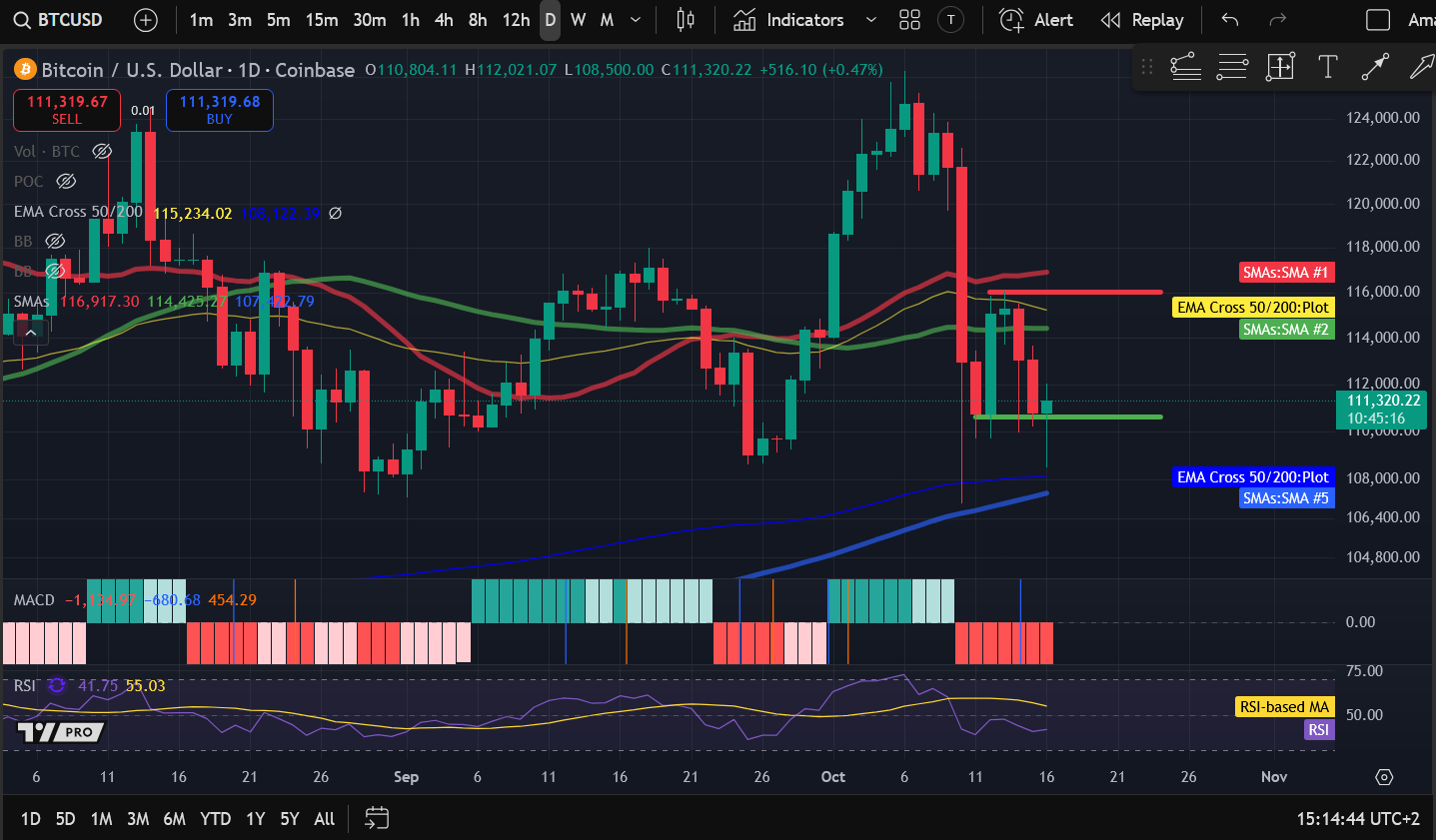
Source: TradingView
BTC and the crypto market crashed on Friday after President Trump announced 100% tariffs on Chinese goods and new export controls for software. The announcement was made in retaliation for China's imposition of restrictions on rare earth mineral exports. As a result, BTC plunged to $102,000 on Binance before recovering and settling at $112,980. Selling pressure persisted on Saturday as the price fell almost 2% to $110,768. Despite the overwhelming selling pressure, markets recovered on Sunday. As a result, BTC rose nearly 4% to reclaim $115,000 and settle at $115,067. The price faced selling pressure and volatility on Monday, ultimately registering a marginal increase and settling at $115,274. Selling pressure returned on Tuesday as BTC fell to an intraday low of $109,945. It recovered from this level to reclaim $113,000 and settle at $113,068, ultimately dropping 1.91%. Sellers retained control on Wednesday as the price fell 2% to $110,804. BTC fell to an intraday low of $108,500 during the ongoing session, but has rebounded to reclaim $111,000 and is currently trading around $111,290, up 0.44%.
Ethereum (ETH) Price Analysis
Ethereum (ETH) is struggling to stay above $4,000 despite being up almost 2% during the ongoing session. The altcoin started the week in positive territory, but lost momentum on Tuesday, dropping to a low of $3,894 before reclaiming $4,000 and settling at $4,129. Selling pressure persisted on Wednesday as the price fell over 3%, slipping below $4,000 and settling at $3,988. ETH is trading around $4,050 during the ongoing session.
ETH experienced considerable selling pressure this week, recording $124.7 million in futures liquidations, of which $77.1 million was in long liquidations. CoinGlass analysts believe ETH could decline to $3,500 if selling pressure persists. However, while ETH remains stuck around $4,000, institutional interest is quietly building. Spot Ethereum ETFs registered $170 million in net inflows on October 15. The ETFs had recorded $236 million in inflows the previous day, according to data from SoSoValue. BlackRock’s ETHA led the inflow chart with $164 million, followed by Bitwise and Fidelity. The contrast between ETH’s price action and steady ETF inflows suggests institutional investors are quietly building their positions.
Meanwhile, BitMine’s Tom Lee remains bullish about ETH, doubling down on his prediction that the altcoin could reach $10,000 by the end of the year. Lee reasoned that his outlook about ETH is driven by a convergence of corporate and sovereign adoption, a positive US regulatory environment, and growing institutional adoption.
“Ethereum’s basically been basing for four years now, just broke out of the range, so to me, it wouldn’t be a blow off top, but rather seeking essentially price discovery at a new level.”
ETH started the previous weekend in positive territory, registering a marginal increase on Friday. However, it fell 0.55% on Saturday and settled at $4,487. Positive sentiment returned on Sunday as the price rose 0.62% to reclaim $4,500 and settle at $4,515. Buyers retained control on Monday as ETH rose almost 4% to cross $4,600 and settle at $4,685. Despite the positive sentiment, the price fell by over 5% on Tuesday, settling at $4,451. ETH recovered on Wednesday, rising 1.68%, but was back in the red on Thursday, dropping 3.47% and settling at $4,369.
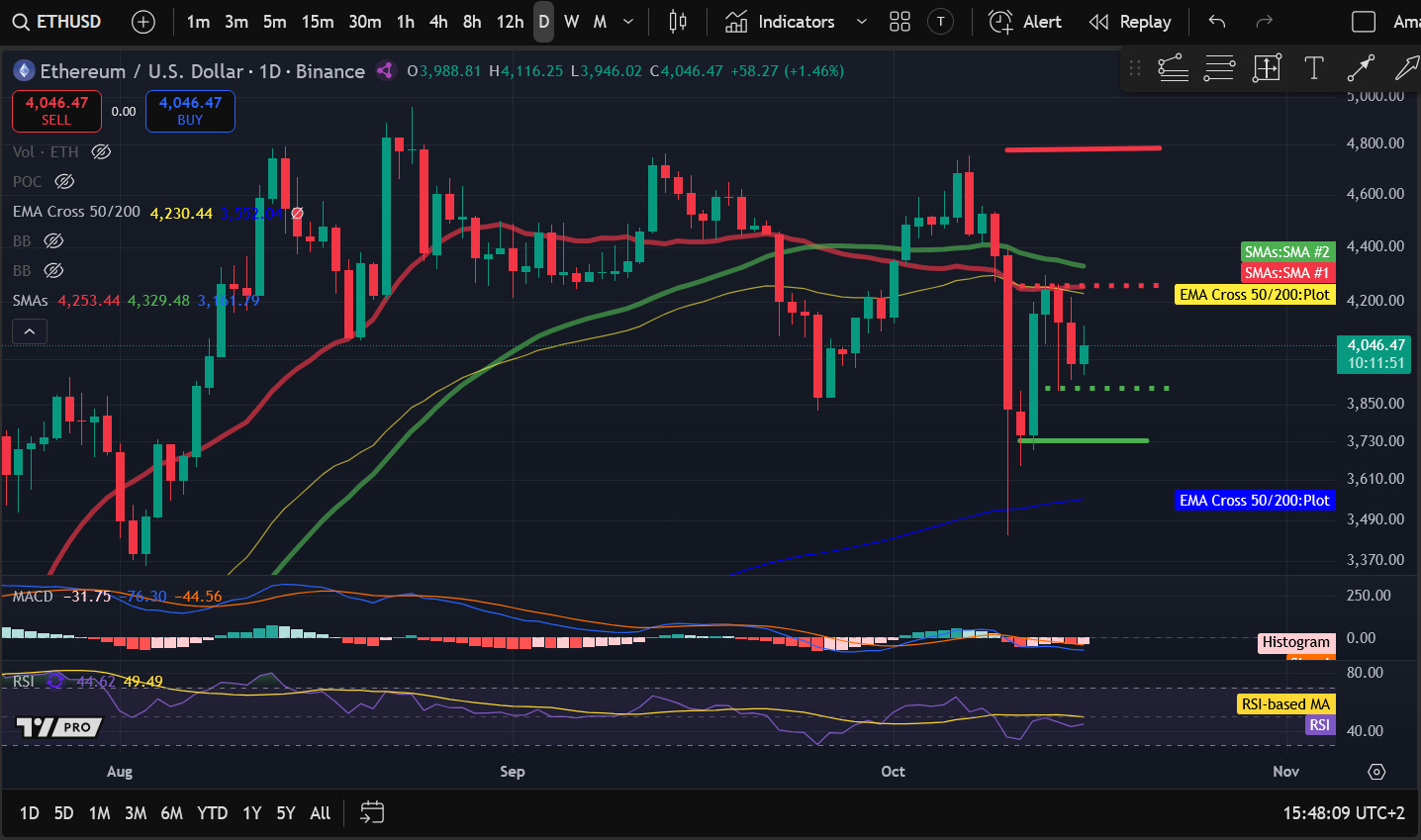
Source: TradingView
ETH plunged to an intraday low of $3,444 on Friday after President Trump announced 100% tariffs on Chinese imports and export controls on key software. It recovered from this level to settle at $3,836, ultimately dropping over 12%. Selling pressure persisted on Saturday as the fell 2.21% to $3,752. ETH recovered on Sunday, rising nearly 11% to reclaim $4,000 and settle at $4,158. Buyers retained control on Monday as the price rose over 2% and settled at $4,224. ETH plunged to an intraday low of $3,895 on Tuesday as selling pressure intensified. However, it recovered from this level to reclaim $4,000 and settle at $4,129, ultimately dropping $4,129. Sellers retained control on Wednesday as the price fell over 3%, slipping below $4,000 to $3,988. ETH is up almost 2% during the ongoing session, trading around $4,050.
Solana (SOL) Price Analysis
Solana (SOL) lost the $200 level again on Wednesday despite reaching an intraday high of $208. The altcoin started the week in bullish territory, rising nearly 6% on Monday. However, sentiment changed on Tuesday as the price fell to an intraday low of $191 before reclaiming $200 and settling at $202, ultimately dropping 2.99%. Selling pressure persisted on Wednesday as SOL fell over 4% to $193. SOL is up over 1% during the ongoing session, trading around $196.
SOL has taken a hit in recent sessions as investor sentiment turns cautious following Friday’s market crash, including a fresh wave of US tariffs on Chinese goods. However, market sentiment is gradually improving thanks to a dovish Fed, and Fed Chair Jerome Powell hinted at two rate cuts before the end of the year. However, traders are likely to be cautious as they watch how the latest trade tensions between the US and China play out. SOL is currently testing the $190 support. A break below this level could drive it towards the $170 mark. However, if bullish sentiment returns, SOL could reclaim $200 and push back towards $240.
SOL started the previous weekend in the red, dropping nearly 1% on Friday and over 2% on Saturday to settle at $227. The price recovered on Sunday, reaching an intraday high of $237 before settling at $238. Buyers retained control on Monday, rising almost 2% and settling at $232. Despite the positive sentiment, SOL returned to bearish territory on Tuesday, dropping over 5% to $220. Despite the overwhelming selling pressure, the price recovered on Wednesday, rising over 4% to $229. Selling pressure returned on Thursday as SOL fell 3.52% to $221.
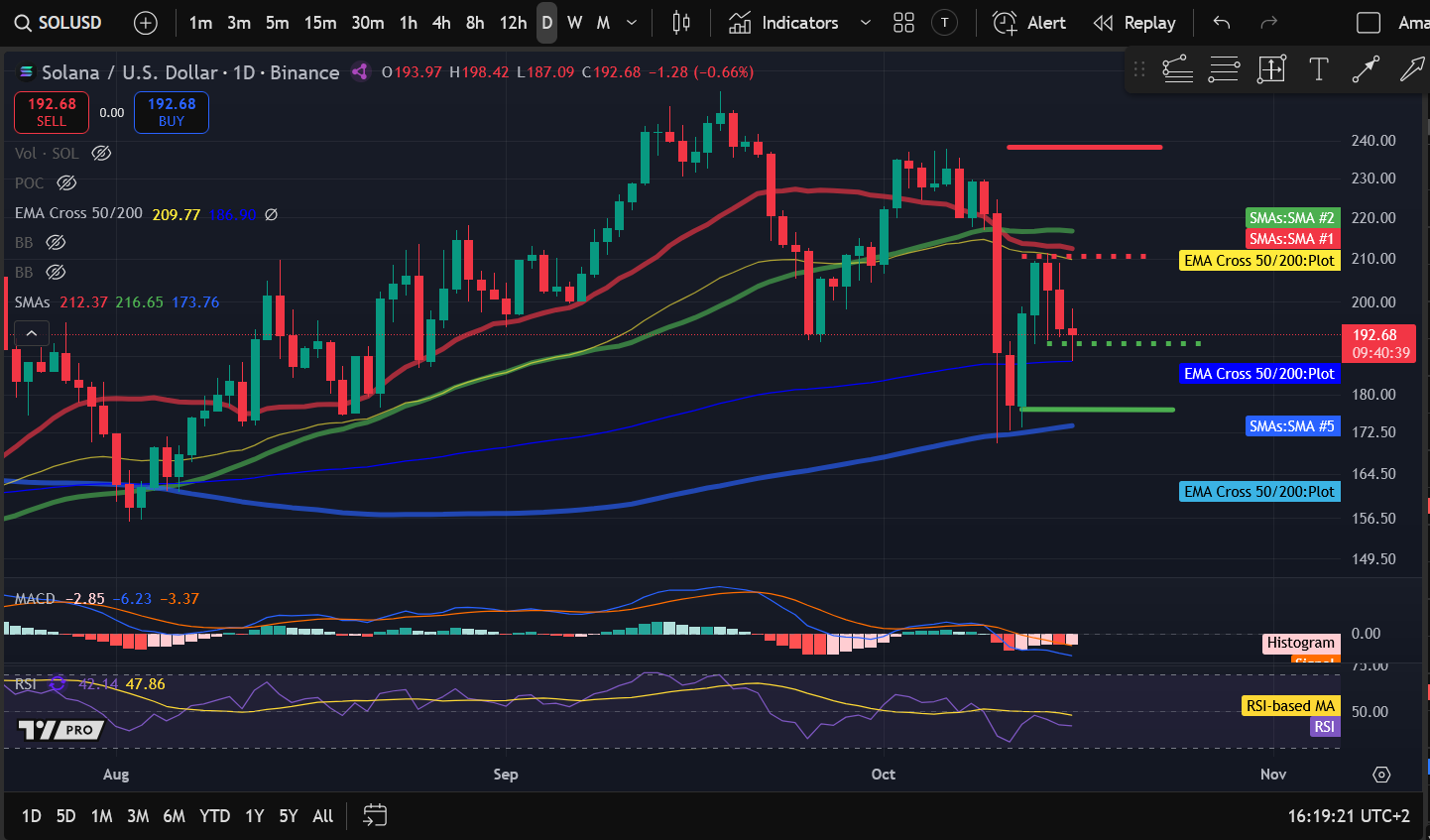
Source: TradingView
Selling pressure intensified on Friday as markets tanked. As a result, SOL plunged to an intraday low of $170 before settling at $188, ultimately dropping over 14%. Sellers retained control on Saturday as the price fell almost 6% to $177. SOL made a strong recovery on Sunday, rising nearly 11% and settling at $197. The price continued pushing higher on Monday, rising almost 6% to reclaim $200 and settle at $208. Despite the positive sentiment, SOL lost momentum on Tuesday, falling to an intraday low of $191 before recovering to reclaim $200 and settle at $202. Selling pressure persisted on Wednesday as SOL fell over 4%, slipping below $200 and settling at $192. SOL is marginally down during the ongoing session, trading around $191.
Celestia (TIA) Price Analysis
Celestia (TIA) started the previous week in positive territory, rising nearly 6% and settling at $1.565. However, it retreated on Tuesday, dropping over 7% to $1.451. Price action turned positive on Wednesday as TIA rose nearly 3% and settled at $1.491. Selling pressure returned on Thursday as the price fell almost 3% to $1.449. TIA plunged to an intraday low of $0.237 on Friday as markets crashed. However, it rebounded from this level and settled at $0.926, ultimately dropping a staggering 36%.
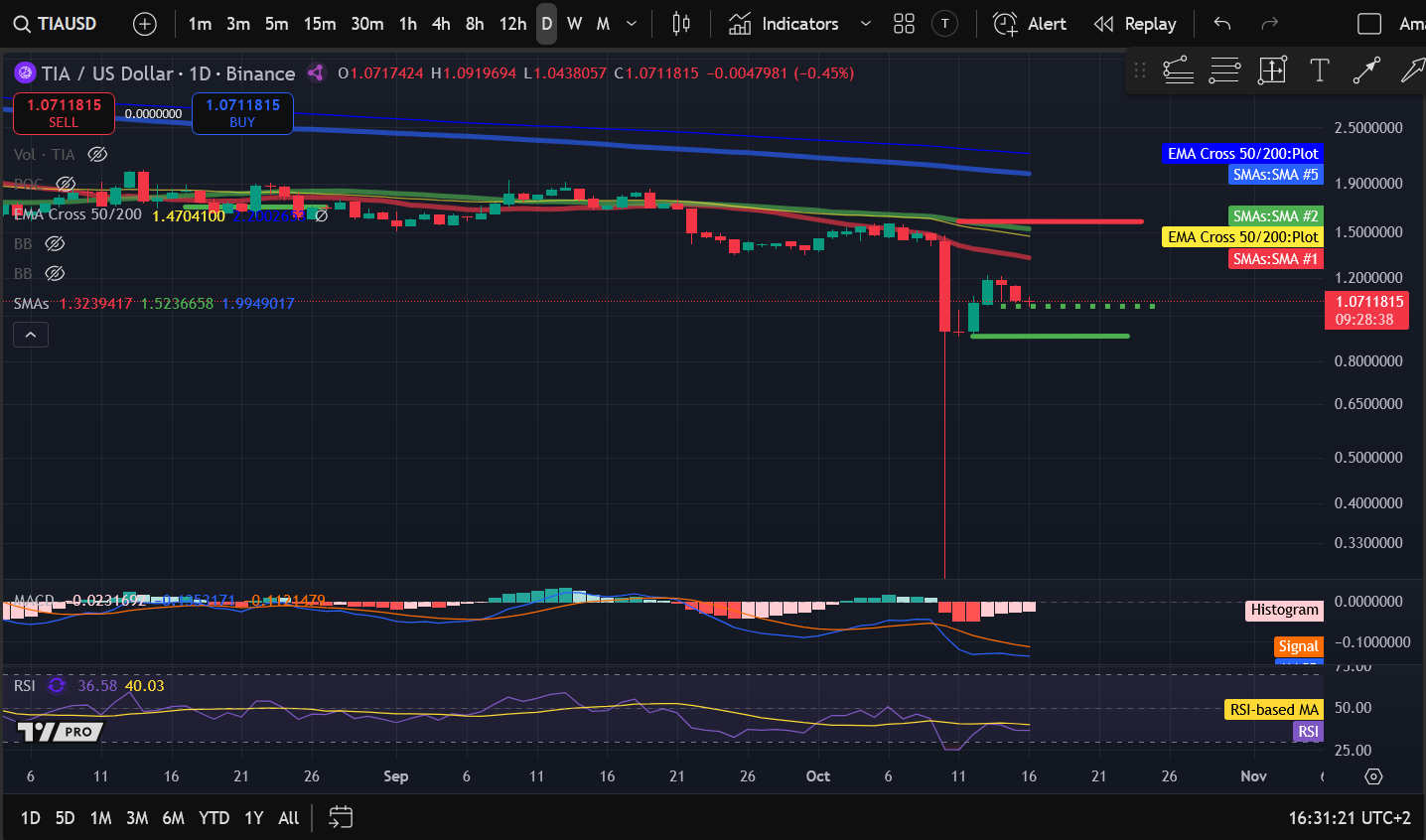
Source: TradingView
Price action was mixed over the weekend as TIA registered a marginal drop on Saturday before recovering on Sunday, rising over 15% to reclaim $1 and settle at $1.062. Buyers retained control on Monday as the price rose over 12% to $1.189. However, selling pressure returned on Tuesday as TIA fell nearly 2% to $1.167. Sellers retained control on Wednesday with the price dropping almost 8% to $1.075. TIA is marginally down during the ongoing session, trading around $1.071.
Optimism (OP) Price Analysis
Optimism (OP) rose 5.57% on Monday (October 7) and settled at $0.756. However, selling pressure returned on Tuesday as the price fell by over 5% to $0.717. OP recovered on Wednesday, rising over 2% to $0.732, but was back in the red on Thursday, dropping 3.43% to $0.707. OP tanked to an intraday low of $0.142 on Friday as markets crashed. It recovered from this level to settle at $0.498, ultimately dropping 29%.
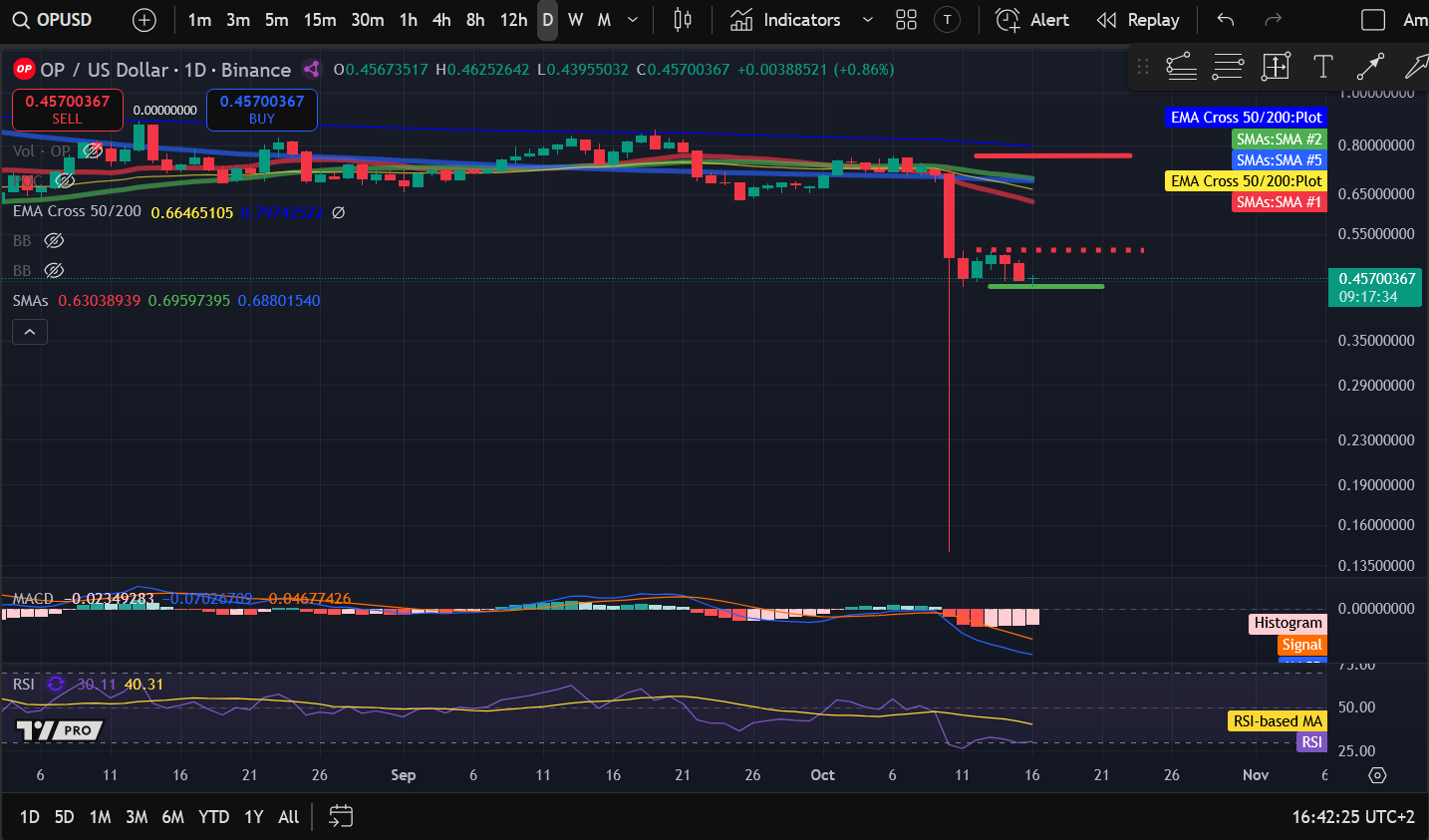
Source: TradingView
Price action was mixed over the weekend as OP fell almost 9% on Saturday before rising 7.58% on Sunday and settling at $0.489. Buyers retained control on Monday as the price rose 2.63% to reclaim $0.50 and settle at $0.502. Selling pressure returned on Tuesday as the price fell by over 3% to $0.485. Bearish sentiment intensified on Wednesday as OP fell almost 7% and settled at $0.453. The price is marginally up during the ongoing session, trading around $0.457.



